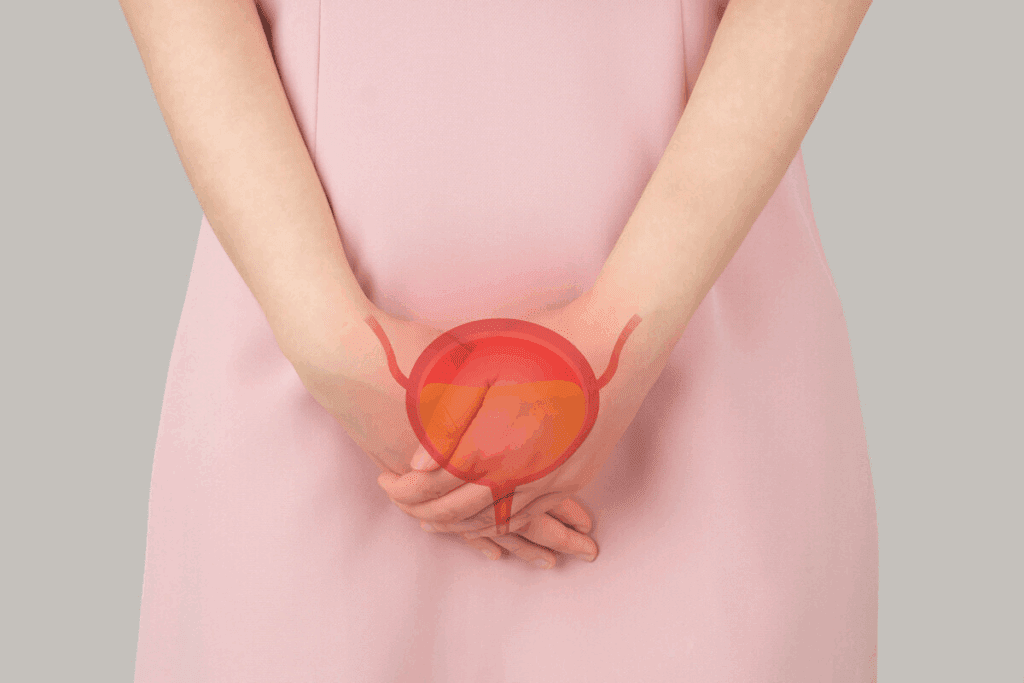Last Updated on November 25, 2025 by Ugurkan Demir

Keeping your healthy urinary system is key for your overall health. Problems like needing to pee a lot or leaking can really affect your day. Luckily, making some lifestyle changes and doing certain exercises can help your bladder function at any age.
Improve your bladder health with 8 natural ways to strengthen your bladder, reduce urgency, and minimize incontinence symptoms.
We’ll look at eight natural ways to boost your urinary bladder health and lower the chance of leaks. Adding these to your daily life can help you stay active. Simple steps, like working your pelvic floor muscles, can really help.

Knowing about bladder health is key to spotting problems early. A healthy bladder is vital for our well-being. It greatly affects our daily life.
A healthy bladder holds urine well and empties fully. It has a strong muscle and normal size. Bladder health depends on our lifestyle, diet, and physical state.
To keep a healthy bladder, we need good habits. Drinking enough water, staying clean, and avoiding irritants are important. Also, watching for changes in our urine habits is vital.
Many people face bladder problems. Nearly 17 percent of women have overactive bladder symptoms, like needing to pee often. Other common issues are urinary incontinence and bladder infections.
These problems can really affect our lives. They cause discomfort, embarrassment, and disrupt our daily routines. Knowing about these issues helps us seek help when needed.
The RISE FOR HEALTH study sheds light on bladder health. It shows bladder health differs among people. This highlights the need for personalized care for our bladders.
Studying such research helps us understand bladder health better. We learn about the factors that affect it. This knowledge guides us to improve our urinary health by avoiding risks.

Strengthening your pelvic floor muscles is key for bladder control and pelvic health. These muscles support your bladder, bowel, and uterus. Exercising them brings many health benefits.
Pelvic floor exercises, or Kegel exercises, are simple yet effective. They help improve bladder strength. By contracting and releasing these muscles, you can better control your bladder and lower the risk of incontinence.
To do Kegel exercises right, follow these steps:
It’s important to relax and breathe naturally while doing Kegel exercises. Don’t tense other muscles, like your abdomen or buttocks.
Being consistent is key with Kegel exercises. To make them a habit:
To track your progress, you can:
| Method | Description | Frequency |
| Self-Assessment | Evaluate your ability to stop urine flow mid-stream. | Weekly |
| Pelvic Floor Muscle Strength Test | Consult a healthcare professional for a strength assessment. | Monthly |
| Symptom Tracking | Monitor your symptoms, such as leakage episodes. | Daily |
By adding Kegel exercises to your daily routine and tracking your progress, you can greatly improve your pelvic floor strength and bladder health.
It’s important to have good urination habits for a healthy bladder. By following regular practices, you can better control your bladder. This can also lower the chance of urinary tract problems.
Having a set time to go to the bathroom is key. Try to go every 3 to 4 hours. This helps your bladder work better with your brain, leading to better control. You can adjust this based on how much you drink and your needs.
Benefits of a Regular Urination Schedule:
It’s also important to empty your bladder fully. Double voiding is a good technique. This means you urinate, lean forward, and then try to urinate again. It helps get rid of all urine, which is good for your bladder.
The Importance of Proper Technique: Using the right way to urinate can greatly improve your bladder health. By making sure you empty your bladder fully, you can avoid problems like infections and incontinence.
Don’t delay going to the bathroom. Waiting too long can make your bladder smaller and less controlled. Listen to your body and go when you need to. This keeps your bladder healthy.
| Healthy Habit | Benefit |
| Regular Urination Schedule | Improved bladder control |
| Complete Bladder Emptying | Reduced risk of urinary tract infections |
| Avoiding Urination Postponement | Maintained bladder capacity |
By making these habits part of your daily routine, you can improve your bladder health. This is good for your overall well-being.
Drinking enough water is key for a healthy bladder. It helps prevent urinary problems and keeps the bladder working right.
Drinking enough water stops urine from getting too concentrated. This can irritate the bladder. A good rule is to drink half your body weight in ounces of water each day. For example, if you weigh 150 pounds, aim for 75 ounces of water daily.
But, how much water you need can change. It depends on how active you are, where you live, and your health.
Key considerations for determining your optimal water intake include:
It’s not just about drinking enough water. When you drink it matters too. Drinking water at regular times helps keep your body hydrated all day. It’s recommended to drink water at regular intervals, not all at once.
A suggested approach is to:
Knowing when you’re hydrated is important. Look for these signs:
By watching for these signs and adjusting your water intake, you can keep your bladder healthy.
Changing what you eat can really help your bladder. Making smart food choices can boost your bladder health. This can also lower the chance of bladder problems.
Some foods are great for your bladder. Foods like oats, beans, and berries are full of fiber. This helps prevent constipation, which can lead to bladder issues. Foods packed with antioxidants, such as berries and leafy greens, also help fight inflammation and keep you healthy.
Some things can bother your bladder. It’s best to cut down on caffeine, alcohol, and spicy foods. These can irritate your bladder. Also, artificial sweeteners and acidic foods might cause discomfort for some people.
Creating a meal plan for your bladder means choosing foods wisely. Add more fiber and antioxidants to your diet. Start to cut down on things that irritate your bladder, like caffeine and spicy foods.
Here’s a simple meal plan to help you:
| Meal | Foods |
| Breakfast | Oatmeal with berries and nuts |
| Lunch | Grilled chicken with roasted vegetables and quinoa |
| Dinner | Baked salmon with sweet potatoes and green beans |
By changing your diet, you can improve your bladder health and life quality.
Core strength, hip stability, and bladder control are closely linked. Exercising these areas can improve pelvic health. Strengthening your core and hips supports your pelvic floor, helping with bladder control.
Studies show a strong link between core strength and bladder control. Core muscles, like abs and back, support the pelvic floor. Strong muscles stabilize the pelvis and ease bladder strain.
A study in the Journal of Women’s Health Physical Therapy found that core and pelvic floor training improve bladder control. This shows the value of core exercises for better bladder health.
Hip exercises are key for bladder control. Strong hips stabilize the pelvis, lowering incontinence risk. Here are some effective hip exercises:
| Exercise | Repetitions | Sets |
| Clamshell | 15-20 | 3 |
| Side-lying leg lifts | 10-15 | 3 |
| Squats | 10-12 | 3 |
Adding core exercises to your day is easy. Try planks, bridges, and pelvic tilts. For example, do planks during TV commercials or bridges while brushing teeth.
Medical Expert, a pelvic health specialist, says, “Engaging your core daily improves bladder control and pelvic health.”
Combining core and hip exercises with a healthy diet and good urination habits boosts bladder health and overall well-being.
Adding natural remedies to your daily life can boost bladder health. It’s key to look at the benefits and how they fit into your routine.
Some herbal supplements might help with bladder health. For example, Gosha-jinki-gan can reduce urgency and frequency. Uva ursi and pumpkin seed extract are also used, but more research is needed.
Always talk to a doctor before trying new supplements. They can affect medications or cause side effects.
Vitamin D is important for strong pelvic floor muscles, which help control the bladder. Getting enough Vitamin D through sun, food, or supplements is good for bladder health. Magnesium and potassium also help relax muscles and aid in urination.
There are natural ways to support bladder health. Eating more fiber can help avoid constipation, which puts pressure on the bladder. Probiiotics might also help by keeping the gut healthy, which can benefit the bladder.
Exploring these natural remedies can help you make smart choices for your bladder health. Always check with a healthcare provider to find what’s best for you.
Bladder training can greatly improve bladder control and urinary health. By adding these methods to your daily routine, you can strengthen your bladder. This reduces the risk of urinary problems.
One effective technique is to slowly increase the time between bathroom visits. This trains your bladder to hold more urine, cutting down on bathroom trips. Start by logging your bathroom visits to see your current pattern.
Then, increase the time between visits by 15-30 minutes every few days. For example, if you urinate every hour, try to wait an hour and 15 minutes, then an hour and 30 minutes, and so on. This helps your bladder muscle stretch and become stronger.
It’s also important to manage the urge to urinate. Deep breathing, pelvic floor exercises (Kegels), and distractions can help delay urination until it’s more convenient.
When you feel the urge, take a few deep breaths and contract your pelvic floor muscles. This can calm your bladder and lessen the urgency. Activities that distract you, like reading or working, can also be helpful.
Relaxation techniques are key in managing stress and improving bladder control. Stress can worsen bladder issues, so finding ways to relax is essential.
Some effective relaxation techniques include:
Mindfulness, like meditation and mindful breathing, can reduce stress and improve bladder control. Being more aware of your body and its signals helps manage bladder habits.
A simple mindfulness exercise is focusing on your breath and observing your body’s sensations without judgment. Regular practice can improve bladder control and overall well-being.
Here’s a comparison of different relaxation techniques and their benefits for bladder health:
| Technique | Benefits for Bladder Health |
| Deep Breathing | Reduces stress, improves bladder control |
| Progressive Muscle Relaxation | Relaxes pelvic floor muscles, reduces tension |
| Yoga and Meditation | Improves overall relaxation, reduces stress |
| Mindfulness Practices | Enhances awareness, improves bladder control |
By using these bladder training techniques and stress management strategies daily, you can greatly improve bladder control and urinary health.
By using the strategies from this article, you can make a bladder strengthening plan just for you. We help you create a personalized plan to reach your bladder health goals. This will also boost your urinary health.
First, look at your current habits and see where you can get better. Think about how much you drink, when you go to the bathroom, and your pelvic floor exercises. Changing these can help you control your bladder health and live more confidently.
Try mixing different strategies like pelvic floor exercises, good bathroom habits, and eating right into your day. This will make your bladder stronger and improve your urinary health. With a good bladder strengthening plan, you can see lasting changes and better your life.
A healthy diet and enough water are key for bladder health. Foods high in fiber and vitamins help. So does staying hydrated.
Strengthen your bladder with pelvic floor exercises like Kegels. Try bladder training too. Gradually increase time between bathroom visits.
Stay hydrated and practice good hygiene to keep your urinary system healthy. Avoid harsh soaps and irritants. Drink plenty of water and wipe correctly.
A healthy bladder stores and releases urine well. It doesn’t leak or have frequent urges. Strong pelvic muscles and good health support it.
Try deep breathing, meditation, or yoga to relax your bladder. Managing stress and avoiding irritants also helps.
Yes, you can strengthen your bladder with Kegels and bladder training. A healthy lifestyle also helps. This improves control and reduces incontinence risk.
Drink lots of water and practice good hygiene to clean your urinary system. Avoid irritants. Cranberry juice or supplements can prevent infections.
Lifestyle changes like diet and exercise help heal the bladder. Pelvic floor exercises and stress management are key. Sometimes, medical treatment is needed.
Stay hydrated and eat well to keep your excretory system healthy. Avoid processed foods and manage stress. Regular exercise also helps.
While there’s no specific “detox” for the bladder, a healthy lifestyle helps. Stay hydrated and avoid irritants. Herbal supplements may also be beneficial.
National Center for Biotechnology Information. How to Strengthen Your Bladder 8 Natural Ways. Retrieved from https://www.ncbi.nlm.nih.gov/pmc/articles/PMC8743604/
Subscribe to our e-newsletter to stay informed about the latest innovations in the world of health and exclusive offers!